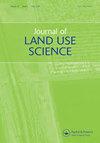潘帕草原生物群落保护区的土地利用与保护目的不相容
IF 3.3
4区 环境科学与生态学
Q1 AGRICULTURE, MULTIDISCIPLINARY
引用次数: 6
摘要
摘要目前,巴西潘帕只有40%的地区仍被原始植被覆盖;然而,保护区的区域生物多样性代表性明显不足。在此,我们评估了巴西潘帕综合保护区的13个PA在保护潘帕自然属性和生物多样性样本方面的有效程度。在分析的所有13个PA中,有11个显示了法律规定区域内的人类土地利用(范围:0.8-39%)。只有六个保护区的自然土地覆盖率超过90%,大多数保护区都有废弃的农田。综合保护区周围的所有缓冲区都有人类土地用途。一半的缓冲区在40%以上的地区有与人类有关的用途。农业马赛克是缓冲区最常见的土地用途。我们的研究表明,大多数潘帕PA都不能免受其内部和周围的人为压力。本文章由计算机程序翻译,如有差异,请以英文原文为准。
Protected Areas of the Pampa biome presented land use incompatible with conservation purposes
ABSTRACT Currently, only 40% of Brazil’s Pampa still is covered by original vegetation; however, there is a clear underrepresentation of regional biodiversity in protected areas (PA). Herein, we assessed the extent to which 13 PAs for the Integral Protection in the Brazilian Pampa are effective in conserving samples of the natural attributes and biodiversity of the Pampa. Of all 13 PAs analysed, 11 showed human land uses (range: 0.8–39%) in the legally defined area. Only six PAs had natural land cover above 90%, and abandoned agricultural fields were present in most of the PAs. All buffer zones surrounding PAs for Integral Protection had human land uses. Half of the buffer zones had human-related uses in more than 40% of area. Agricultural mosaics were the most common land uses in the buffer zones. Our study shows that most Pampa PAs are not immune to anthropogenic pressures both inside and around them.
求助全文
通过发布文献求助,成功后即可免费获取论文全文。
去求助
来源期刊

Journal of Land Use Science
Environmental Science-Management, Monitoring, Policy and Law
CiteScore
5.40
自引率
6.20%
发文量
26
期刊介绍:
The Journal of Land Use Science provides a central outlet for high-quality articles on theoretical and empirical aspects of land-use science at the interface of social and environmental systems. The Journal brings together an array of research perspectives at multiple temporal, spatial and social scales that contribute a better understanding of land-system dynamics and communicate scientific advances towards attaining land-system sustainability.
 求助内容:
求助内容: 应助结果提醒方式:
应助结果提醒方式:


